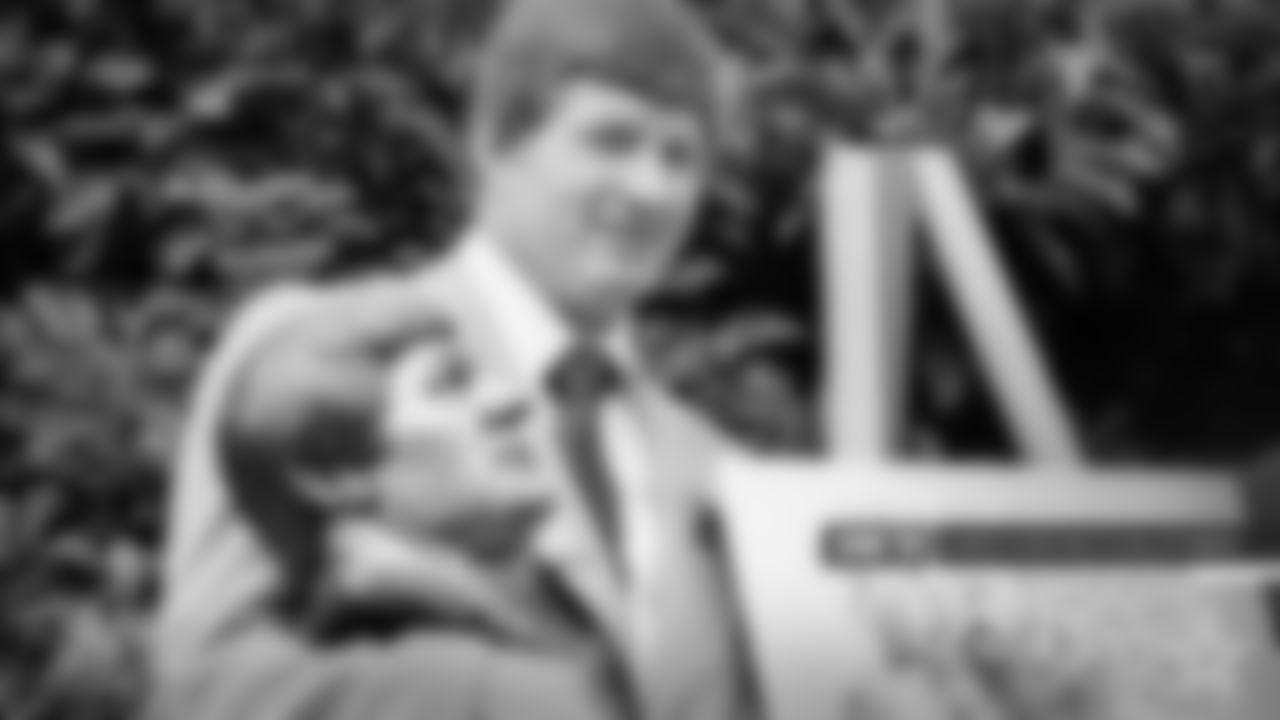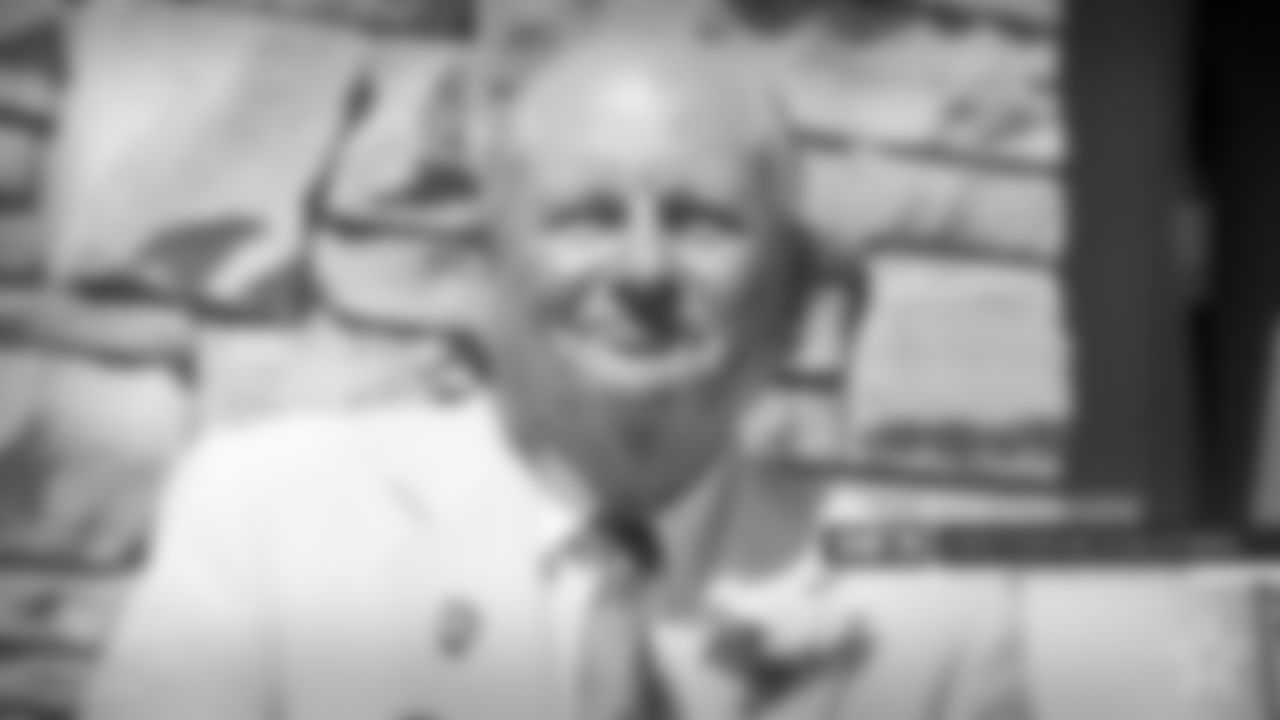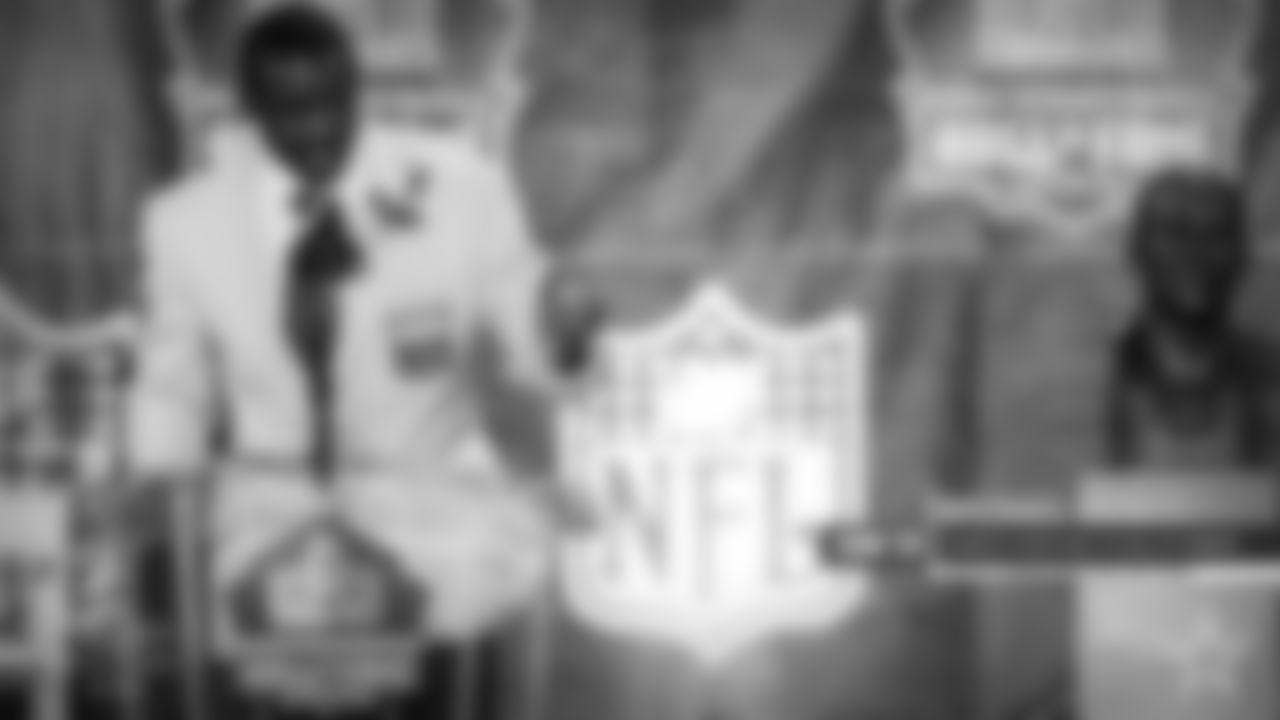Just like that, the Cowboys are now up to 20.
With three more additions last weekend, the Cowboys officially recognize 20 former players/coaches and contributors as members of the Pro Football Hall of Fame.
Legends Drew Pearson and Cliff Harris were joined by former coach Jimmy Johnson as part of a two-year class from 2020 and 2021 that were inducted last weekend.
That gives the Cowboys an even 20 members. That doesn't include the players that have Cowboys ties but didn't play or coach long enough to be recognized fully with the Cowboys, including Bill Parcells, Terrell Owens, Mike Ditka and Herb Adderley.
But the Cowboys still have 20, starting with Mr. Cowboy, the first player inducted back in 1980.
The Cowboys now have 20 Hall of Fame members, thanks to three more additions last weekend. Here's a look at all of the members and their greatest accomplishments.

Bob Lilly – Inducted 1980
Before earning the nickname "Mr. Cowboy," Lilly was the first player ever drafted by the Dallas Cowboys in 1961. So it is fitting that Lilly not only became the first Cowboys player inducted into the Ring of Honor in 1975, but also became the franchise's first player inducted into the Pro Football Hall of Fame in 1980.
During the course of 14 seasons with the Cowboys, Lilly was named Rookie of the Year in 1961, was selected to the Pro Bowl a club-record-tying 11-times, was named to the All-Pro team seven times and played in two Super Bowls, including the club's very first Super Bowl victory, 24-3 over Miami in Super Bowl VI.
Lilly set the standard for what it meant for a Cowboy to be in the Pro Football Hall of Fame, and 19 players have lived up to that standard in the 41 years since.

Roger Staubach – Inducted 1985
Staubach's Hall of Fame career is even more impressive considering the Cowboys had to wait five years after drafting him so that he could fulfill his military commitments. In 1969 he finally began what would arguably be the most memorable and revered career in Cowboys' history. Over the next 11 years he was selected to six Pro Bowls and was named the NFL Players Association Most Valuable Player in 1971.
Staubach owns the second-most passing yards in club history, 22,700, and his 3,586 in 1979 still ranks as the sixth most passing yards in a single season for the Cowboys. He also still leads the club with a career average of 7.67 yards-per-attempt. Staubach also became known as "Captain Comeback" for his 23 fourth-quarter come-from-behind victories in regular season and playoff games, including 14 in the final two minutes or overtime. He coined the term "Hail Mary" with 2021 Hall of Fame inductee Drew Pearson.
In total, Staubach appeared in two Super Bowls and led the Cowboys to victory twice.

Tom Landry – Inducted 1990
Tom Landry paced the sidelines as the "only head coach" in Dallas Cowboys history for 29 years in his trademark fedora. By the time Landry's coaching career ended following the 1988 season, he had compiled a 270-178-6 record, the third most wins in NFL history.
It's unlikely that any coach in professional sports will be remembered as iconically as Landry , who led the Cowboys to two Super Bowl titles, five Super Bowl appearances, five NFC Championships, 13 division titles and an incredible 20 consecutive winning seasons.
As head coach of the Cowboys, Landry introduced more innovations to the game, including offensive motion. Very seldom did the Cowboys run a play from the formation they initially lined up in after breaking the huddle. Landry brought back the shotgun formation, popularized situational substitutions and concocted the "Flex" defense.
The legendary coach, born Sept. 11, 1924, in Mission, Texas, died Feb. 12, 2000 of leukemia.

Tex Schramm – Inducted 1991
Schramm was, to anyone who followed football in North Texas from 1959-1989, considered the original architect of the Cowboys' success. Better known as "Tex," rose to Professional Football Hall of Fame status during his 29 seasons as president and general manager of the Dallas Cowboys, turning a 1960 expansion franchise in Dallas into one of the most successful franchises in NFL history.
Beyond just helping the Cowboys succeed, Schramm was an NFL pioneer and innovator. Under his watch, the Dallas Cowboys were always on the cutting edge with revolutionary ideas and visions. He was instrumental in creating the Dallas Cowboys Cheerleaders, the first of their kind in professional football, developing the Cowboys Ring of Honor and bringing an annual Cowboys Thanksgiving Day game to the nation. He was also instrumental in the merging of the NFL and the American Football League in 1966.

Tony Dorsett – Inducted 1994
The Cowboys acquired Dorsett in a 1977 draft-day trade, and the deal paid dividends in his very first year with the Cowboys, the four-time All-American picked up where he left off in college, rushing for 1,007 yards to earn NFL Offensive Rookie of the Year honors and at the time, set the rushing bar for rookie running backs in Dallas.
One of the greatest running backs in NFL history (so says Cowboys legend Roger Staubach), by 1988 while playing his final NFL season with the Denver Broncos, Dorsett moved into second place on the NFL all-time rushing list with 12,306 rushing yards, and eventually finished his career with 12,739 yards. To this day he ranks 9th all-time in rushing yards.
By the time Dorsett completed his 12-year career, he had collected a victory in Super Bowl XII, four Pro Bowl selections, one All-Pro honor and three All-NFC selections.

Randy White – Inducted 1994
The No. 2 pick in the 1975 NFL Draft, before White's career was over, 14 years later, he would become known as the "Manster" – half man, half defensive monster – setting numerous franchise records as the heart-and-soul of the famed "Doomsday Defense.
Tom Landry tried to convert White to linebacker as a rookie, but soon after he moved him back to defensive tackle in 1977, White became one of the NFL's most dominating defensive linemen and a coveted co-Super Bowl MVP with Harvey Martin in Super Bowl XII. White also was selected to nine Pro Bowls, ranking third in franchise history for Pro Bowl appearances. White's 16 sacks in 1978 rank third in franchise history for a single season, and he still remains third all-time in career tackles with 1,104 and second with 701 career solo tackles.

Mel Renfro – Inducted 1996
Renfro was a running back in college, but Tom Landry saw his potential as a defensive back, and his intuition paid off. During Renfro's 14-year career he became arguably the best safety/cornerback to ever play for the Cowboys, and one of the best to ever play in the NFL. His 52 career interceptions still stand as a team record.
His accomplishments speak for themselves: He was selected to a Pro Bowl in each of his first 10 seasons in the NFL – the first six at free safety and the final four at cornerback and he was a four-time All-Pro, playing in four Super Bowls and eight NFC Championships. He won two Super Bowls with the Cowboys, and he was the prototype for defensive backs that would thrive in the NFL decades later; a speedy playmaker who contributes on both defense and special teams.

Troy Aikman – Inducted 2006
In 12 NFL seasons, Troy Aikman became one of the game's great quarterbacks. As just the third player in NFL history to lead a team to three Super Bowl victories, Aikman rewrote virtually every passing record in Cowboys history. He closed his career with 94 regular season wins, including 90 in the decade of the 1990s – making him the winningest starting quarterback of any decade in NFL history to that point.
Known by many younger NFL fans as one of the game's top in-booth commentators, the former No. 1 overall pick eventually teamed up with Emmitt Smith and Michael Irvin, together known as "The Triplets," to take over the NFL for a stretch of the 1990s. In the postseason Aikman truly shined. His four 300-yard passing days were the third best total in NFL history, and he holds the club records for postseason pass attempts (502), completions (320), yards (3,849), and completion percentage (63.7%). In addition, Aikman's 23 career postseason passing touchdowns was just one shy of Staubach's club record of 24.

Rayfield Wright – Inducted 2006
Only nine players have played football for the Dallas Cowboys longer than Rayfield Wright, and only five players in the history of the Cowboys organization have been to more Pro Bowls than Wright's six. For the majority of the 1970s, Wright was acknowledged as the NFL's premier offensive tackle. Wright was selected to six straight Pro Bowls (1971-76) as a tackle while earning All-Pro honors four times and earning recognition on the NFL's all-decade team for the 1970s.
Perhaps not brought up as often, the success of Roger Staubach (and running back Calvin Hill) is owed in large part to Wright's blocking. In his 13-year NFL career with the Dallas Cowboys, Wright was a key contributor to teams that had 13 straight winning seasons, made 12 playoff trips and won 10 division titles. He also played in eight conference championship games and won five NFC Championships and two Super Bowls.

Michael Irvin – Inducted 2007
Despite having his career cut short due to a spine injury, Michael Irvin left the NFL following the 1999 season owning or tied for 20 Cowboys receiving records. To this day, Irvin is the first image to come to mind for a Cowboys receiver, and perhaps more notably, is a symbol of toughness and competitiveness for an organization that's never shied away from the spotlight.
Irvin was the playmaker of "The Triplets," led by him, Troy Aikman, and Emmitt Smith. The wide receiver won three Super Bowls and was selected to five Pro Bowls. Of his 750 career regular season catches, 95 went for 20-29 yards, 38 for 30-39, 18 for 40-49, 10 for 50-59 and nine for 60 yards-or-more.
Known for never being afraid to run routes down the middle of the field where he was vulnerable to big hits, after entering the League in 1988, he started 147-of-159 regular season games (163-of-175 including playoffs). Irvin did not miss a start due to injury after the 1990 season.

Bob Hayes – Inducted 2009
In his 10 seasons with the Dallas Cowboys, "Bullet" Bob Hayes revolutionized the wide receiver position and the way defenses would play in the NFL. He began his 11-year NFL career after winning two Olympic gold medals at the 1964 Olympic Games in Tokyo, Japan. He tied the world record (10.06 seconds) in the 100-meter dash and claimed his second gold medal running the anchor leg of the 400-meter relay to earn the title of "The World's Fastest Human." He arrived in Dallas in similar
fashion to become -- and remain -- the only rookie in franchise history to ever lead the team in receptions (46), receiving yards (1,003) and a rookie club record of 12 touchdown catches. His 12 touchdown receptions as a rookie are currently tied for fourth in league history. His speed and threat of being able to go long forced teams to install the zone defense to corral Hayes.
Hayes finished his Cowboys career with 365 catches (eighth), for 7,295 yards (sixth) and 71 touchdowns (second). In club record books, Hayes still holds team receiving marks for most points in a game (24, tied), most touchdowns in a game (four, tied), most receptions by a rookie, season (46), most receptions by a rook- ie, game (eight, tied), longest reception (95t), highest career receiving average (20.0), highest single-season receiving average (26.1), touchdowns in a season by a rookie (12) and touchdowns in a game (four, tied).

Emmitt Smith – Inducted 2010
In 15 seasons - 13 with Dallas - Emmitt Smith made an impact on the NFL that few players can match at any position or in any era. As the NFL's all-time leading rusher, Smith also won four NFL rushing titles, three Super Bowl titles and a league (1993) and Super Bowl (XXVIII) MVP award. He was selected to the Pro Bowl eight times, and on the club's offense, only Jason Witten (11) and Larry Allen (10) were selected to more in club history. Among NFL running backs, only Barry Sanders (10) was selected more times. With 975 rushing yards in 2002, Smith became just the seventh player in NFL history to carry the title of all-time rushing leader, taking that designation from Walter Payton.
After 13 seasons in Dallas, Smith had 17,162 career rushing yards, and he moved past Payton's 16,726 career yard mark in Week Eight of the 2002 season against Seattle. Smith finished his pro career with 18,355 yards and is also the NFL's career rushing touchdowns leader (164), and second in league annals in total touchdowns (175), trailing Jerry Rice by 33. The first player in NFL history to post five straight seasons with over 1,400 yards rushing, Smith, Jim Brown and LaDainian Tomlinson are the only players with seven straight 10-touchdown seasons to start their career. With 1,021 yards rushing in 2001, Smith became the first player in NFL history to rush for 1,000 yards in 11 consecutive seasons and the first to post 11 1,000-yard rushing seasons in a career.
Smith holds the NFL record for career rushing attempts with 4,409, passing Payton (3,838) in Week Three of the 2002 sea- son. With a then NFL-record 25 rushing touchdowns in 1995, Smith scored 100 career touchdowns in just six seasons, originally the fastest anyone in league history had reached that mark. Smith also tied Brown's NFL record by scoring 100 touchdowns in just 93 career games. Since Smith's accomplishment, Tomlinson reached the feat in 89 games. His 25 career scores against the Arizona Cardinals is tied for the third-best total by a player against an opponent since 1970, followed by his 24 scores against Washington and the N.Y Giants.
His value to the Cowboys success can be seen in the club's 99-26 mark (91-24 in regular season) when he carried the ball 20-or-more times a game and 64-19 record (57-19 in regular season) when he rushed for 100 yards. The century mark became a big number in Smith's career, having rushed for 100 yards in 155-of-326 games dating back to high school, including 83-of-218 games with Dallas, including playoffs. In NFL annals, Smith's 78 regular season 100-yard rushing games is a record. Included in Smith's club-record 76 100-yard rushing games are 11 of the top 15 performances in team history and 18 days with over 150 yards (the fourth highest total of 150-yard games in NFL history). Smith rushed for over 100-yards against 22 of the 32 NFL teams.

Deion Sanders – Inducted 2011
On Sept. 9 1995, the Dallas Cowboys made the biggest free agent move in the franchise's history by signing Deion Sanders to a long term contract. In doing so, Dallas was able to secure the services of one of the most talented cornerbacks in the history of the NFL. Sanders, who spent time with five different NFL teams, scored a total of six touchdowns on punt returns, three on kickoff returns, and returned nine interceptions for scores. The multi-faceted athlete also returned one fumble for a touchdown and had 60 receptions for 784 yards and three touchdowns with the Falcons (1989-1993), San Francisco 49ers (1994), Dallas Cowboys (1995-99), Washington Redskins (2000) and Baltimore Ravens (2004-05). In all, he recorded 53 interceptions including five with the Ravens when he returned to the field after a three-year retirement.
Sanders was an extremely gifted and versatile athlete, who was also a Major League Baseball player. As a baseball player, Sanders spent time with the New York Yankees (1989-90), Atlanta Braves (1991-94), Cincinnati Reds (1994-95, 1997, 2001) and San Francisco Giants (1995). He is the only man in professional sports to play in both a World Series (batting at a .533 World Series clip with Atlanta in 1992) and in the Super Bowl (with victorious San Francisco and Dallas teams following the 1994 and 1995 seasons).
In 1996, he decided to play football full-time. Sanders started 16 regular season games at cornerback and another eight at wide receiver – becoming the first two-way starter in the NFL since the Philadelphia Eagles Chuck Bednarik, who retired in 1962. At the completion of the 1996 football season, Sanders returned to baseball, signing with the Reds, and led the league in stolen bases (56) in the 1997 season before returning to football on a full-time basis in September.
He was selected to eight Pro Bowls, and became a member of the NFL's All-Decade Team of the 1990s as both a cornerback and a punt returner, leading the NFL in punt returns in 1998. He also led the NFC in kick- offs in 1992 and interceptions in 1991 and 1993. He was named first-team All-Pro nine times at cornerback in addition to receiving All-NFL acclaim by some media outlets as a kick returner in 1992 and as a punt returner in 1998. Sanders won two Super Bowls during his career. He started at right cornerback for the 49ers in their 49-26 victory over the San Diego Chargers in Super Bowl XXIX and at left cornerback in the Cowboys 27-17 win over the Pittsburgh Steelers in Super Bowl XXX.

Larry Allen – Inducted 2013
As a member of the NFL's All-Decade team for the 1990s and 2000s, Larry Allen was widely recognized as one of the NFL's premier offensive linemen, and he established himself as one of the most decorated offensive players in Dallas Cowboys and NFL history.
In 14 NFL seasons since being drafted in the second round out of Sonoma State, Allen was named to more Pro Bowls (10) than any other offensive lineman in Cowboys history. He also earned another Pro Bowl berth in 2006 while finishing his career with the San Francisco 49ers, bringing his Pro Bowl total to 11 selections. He was also named All-Pro seven times, six times at guard (1995-97, 1999-01) and once at tackle (1998). With his Pro Bowl selection at tackle in 1998, he became just the third player in league history to be selected to the Pro Bowl at more than one offensive line position during his career, joining Bruce Matthews (guard/center) and Chris Hinton (guard/tackle).
Allen is tied with Mel Renfro for the second-most Pro Bowl selections by a Cowboy, trailing Bob Lilly (11) and Jason Witten (11).
He played all but one position along the offensive line in his 12 seasons in Dallas, moving between right tackle (1994), right guard (1995-97), left tackle (1997-98) and left guard (1999-03). During his illustrious career in Dallas, Allen was a member of an offensive unit that posted the four lowest sacks allowed totals in club history with 18 in 1995, 19 in 1996 and 1998, and 20 in 1994. He also played a very important part in Smith's race toward the all-time NFL rushing mark, having blocked for eight of Smith's 11 1,000-yard rushing seasons. Smith gained 11,463 of his 17,162 career yards with Dallas after Allen joined the Cowboys in 1994 and was a pivotal member of the Super Bowl XXX Champion team in 1995.
With a career-best bench press of 700 pounds and a squat lift of 900 pounds, Allen is also considered to be the strongest man to ever play professional football. After missing most of 2002 with a sprained left ankle that required surgery to remove bone spurs, Allen went on to start 48 straight games before signing and playing for two seasons (2006-07) with San Francisco where he started the final 27 games of his career. Allen started 197-of-203 career games played.

Charles Haley – Inducted 2015
One of the most gifted pass rushers in his time in the NFL, Charles Haley left Dallas as the only player in league history to collect five Super Bowl rings. A mainstay on the Cowboys defensive line since arriving in Dallas via a trade with San Francisco in 1992, Haley earned his final ring in a 27-17 win over Pittsburgh in Super Bowl XXX. As a starter on Super Bowl contenders from his first day in the league, Haley played on 11 playoff teams in his 12 years in the league. Haley joined the San Francisco
49ers in 1986 as the team's fourth round draft pick and developed into one of the NFL's most devastating pass rushers during a career split between the 49ers and Dallas.
Haley was a member of two 49ers championship teams (Super Bowls XXIII and XXIV) before his trade to Dallas. He earned three more Super Bowl rings during his first four seasons with the Cowboys.
Haley began his NFL career at linebacker and led San Francisco in sacks in each of his first six seasons. He recorded four double-digit sack totals with the 49ers, including 12 sacks as a rookie and a career-high and NFC-leading 16 sacks in 1990. He was moved to defensive end after his trade to Dallas and continued to excel at pressuring the quarterback. He added two more double-digit sack seasons in 1994 and 1995. Haley then suffered a serious back injury in 1996 that limited him to just five games. He retired after undergoing surgery. However, after a two-year hiatus, Haley re-signed with the 49ers as a backup defensive end for two playoff games in 1998. He came back to play one final season in 1999 and added three sacks to his career total.
When he walked away for the final time, Haley had amassed 100.5 sacks during his 169-game career.

Jerry Jones – Inducted 2017
Recognized around the NFL as one of his era's most influential and passionate owners, Jerry Jones was selected for induction to the Pro Football Hall of Fame as a contributor in February of 2017.
In addition to becoming the first NFL owner to lead his franchise to three Super Bowl titles (1992, 93 and 95) in a four year period of time, Jones' efforts in the areas of sports marketing, promotion, stadium development, and network television negotiations created a lasting imprint on the landscape of the NFL and the American sports culture.
Since his purchase of the Cowboys in 1989, the team has won 10 division titles, while advancing to the postseason 14 times and reaching the NFC Championship game four times.
As Dallas' general manager, Jones has overseen personnel efforts that include the acquisition of 50 different players who have combined for a collective total of 147 Pro Bowl appearances. Six Cowboys players from Jones' tenure of ownership have been inducted into the Pro Football Hall of Fame -- Troy Aikman, Michael Irvin, Emmitt Smith, Deion Sanders, Larry Allen and Charles Haley - while Jones has served as the presenter for three of those men: Irvin, Smith and Allen.
The lasting landmarks to Jones' legacy of promoting and protecting the future of the sport of football can be seen in the conception and construction of AT&T Stadium in Arlington, Texas and The Star in Frisco, Texas. The stadium, which opened in 2009, has a capacity of over 100,000 and is the largest and most technologically sound indoor/outdoor stadium in the world. The Star, which serves as the world training headquarters for the Dallas Cowboys, is a state-of-the-art venue that enjoys a first-of-its-kind partnership with its surrounding community in Frisco, Texas, and the young men and women who compete in athletics at the high school and youth sports levels.
On the league level, Jones has served lengthy stints on nearly every significant NFL ownership committee, including the Competition Committee, the Broadcast Committee, the Management Council's Executive Committee, the Health and Safety Advisory Committee, and he is currently the chairman of the NFL Network and Pro Football Hall of Fame Committees.
Jones, who became the 15th NFL owner to be selected for induction into the Hall of Fame, is the only man in football history to both play for a collegiate national championship football team and own a Super Bowl winning club.

Gil Brandt – Inducted 2019
From the inception of the Dallas Cowboys in 1960, to 13 division titles, two Super Bowl titles and 20 consecutive winning seasons, Gil Brandt was behind the scenes as the man responsible for finding the next Cowboys cornerstone player. Throughout his tenure with the Dallas Cowboys, Brandt oversaw the acquisition of 15 of the 19 players who are currently in the Ring of Honor - including two undrafted free agents in Cliff Harris and Drew Pearson, a pair of seventh round selections in Rayfield
Wright and Bob Hayes, and a 10th round draft choice by the name of Roger Staubach. From that group, nine men also earned induction into the Pro Football Hall of Fame.
In 30 years with the Cowboys, Brandt distinguished himself at the top of his profession - as an innovator - and someone who set the standard for excellence in the area of player personnel. Whether it be introducing computers and technology into the player evaluation process, negotiating contracts, or inviting 80 undrafted rookie free agents to training camp every year, Brandt brought new and creative philosophies to player acquisition that were copied by many teams in the NFL - and are still being used today.

Jimmy Johnson – Inducted 2021
Jimmy Johnson was named the first Cowboys head coach under then new owner Jerry Jones in 1989. He arrived in the pro ranks after a very successful collegiate coaching career that included a national championship with the University of Miami.
In five seasons with the Cowboys, Johnson guided the team to two Super Bowl championships. In his first season in Dallas, Johnson's team finished 1-15, then 7-9 in 1990 before making a return to the playoffs in 1991 with an 11-5 finish.
The Cowboys then returned to the top of the NFL in 1992 and 1993 with back-to-back Super Bowl titles. Both seasons, Dallas claimed NFC Eastern Division titles, defeated the San Francisco 49ers in the NFC Championship game and overcame the Buffalo Bills in the Super Bowl.
Johnson left Dallas after compiling a 44-36 regular season record (.550 winning percentage) and an impressive 7-1 postseason mark (.875). He coached 10 Pro Bowl players who earned a combined 22 Pro Bowl selections in his five seasons in Dallas. Johnson also coached five future Hall of Famers in the peak of their careers - Troy Aikman, Larry Allen, Charles Haley, Michael Irvin and Emmitt Smith.

Drew Pearson – Inducted in 2021
Drew Pearson played 11 seasons with the Dallas Cowboys, beginning a long-standing tradition of greatness from players to don the number 88 jersey. A former undrafted free agent, Pearson was named to the All-Decade Team of the 1970s as he earned a niche as one of the top clutch receivers in football history, best exemplified by his 50-yard touchdown connection with Roger Staubach in what would be dubbed as the first ever Hail Mary play.
He led the team in receptions and receiving yards four consecutive seasons (1974-77) and recorded two 1,000-yard campaigns. In an era where passing offenses had not yet evolved into high powered aerial attacks, Pearson soared past his offensive peers, posting the most 800-yard receiving seasons (five) of any player in the 70s - including two 1,000-yard campaigns that were tied for the most by any player - and six seasons with 40-or-more catches to tie for the second-most.
Over the course of 156 games in Dallas, Pearson totaled 489 catches for 7,822 yards and 48 touchdowns, becoming the third Cowboys player to surpass 7,000-career yards. Combined with his 189 rushing yards, Pearson was the first Cowboys player to ever reach 8,000 scrimmage yards, and to this day, is only one-of-seven Cowboys players to reach that mark. Pearson ranks fifth in Cowboys history with a career average of 16.0 yards-per-reception. Pearson had a penchant for scoring long touchdowns, and of his 48 career touchdowns through the air, he scored 22 from 20-plus yards.

Cliff Harris – Inducted 2021
Arriving in Dallas in 1970 as an undrafted free agent from tiny Ouachita Baptist in Arkansas, Cliff Harris went on to crack the starting lineup as a rookie, before missing time to military service. Harris then started the next nine consecutive years and earned six consecutive Pro Bowls and four straight All-NFL teams.
A key member of two Super Bowl winning teams, and teams that earned three more trips to Super Bowls in the 70s, Harris was at his best in the postseason, finishing his career with six interceptions in 21 playoff games and earned a spot on the 1970s NFL All-Decade Team.
Harris, who earned the nickname "Captain Crash" by his teammates for his punishing hits and reckless pursuit of ball carriers, finished his 10-year Cowboys career with 29 interceptions and 16 fumble recoveries - tied for second in team history. Harris also guided the defense to a top-10 finish in each of his 10 seasons with Dallas, including the best defense in the league in 1977. When he retired, his 29 interceptions ranked fifth on the team's all-time interceptions list.















